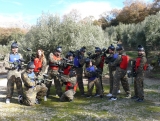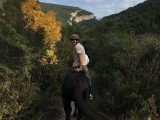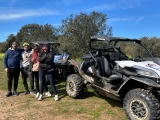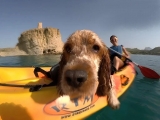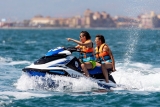Located in the Region of Murcia, at the base of the strip of land separating the Mediterranean Sea from the Mar Menor, known as La Manga, lies Cabo de Palos. A fishing town that forms part of the Mar Menor Nautical Station.
During the summer months, it undergoes a significant transformation as its population swells with visitors from all over. However, it’s visited year-round by many divers eager to explore its fascinating seabeds.
From the Cabo de Palos lighthouse heading northwest, about two miles out, lies another small lighthouse marking the position of the Islas Hormigas. Two small islets, La Hormiga and the even smaller Hormigón, break the surface. Along those two miles, you’ll find a series of intriguing shallows, home to the full range of typical Mediterranean underwater fauna.
Declared a Marine Reserve in 1995, it has restrictions on certain activities like spearfishing and boat fishing. There’s also a no-take zone where anchoring and recreational boating are prohibited. This exclusion area includes the Islas Hormigas and the Bajo de Fuera, located half a mile northwest of La Hormiga.
The "Bajo de Fuera"
The "Bajo de Fuera" is a restricted site, accessible only to divers with permits issued by what was formerly known as the Ministry of Agriculture, Fisheries and Food (MAPA). Its peak lies just three metres below the surface, which is why, until the mid-20th century, it was the site of numerous shipwrecks, earning its reputation as a graveyard for ships.
Its depths hold several wrecks, including the Southampton, Casenga, Izaro, S.S. Haendel, Nova América, and Sirius, among others. The Sirius is the most famous—an Italian transatlantic that sank after hitting the "Bajo de Fuera" in the early hours of 5 August 1906, with 822 passengers on board. 
Its remains, split into two parts, are scattered across both sides of the shallows. The southern face of this underwater mountain slopes gently down to -40 metres, while the northern face drops sharply to -60 metres. At the bottom of this side lie two large wrecks: the S.S. Haendel, hull-up, and nearby, the Nova América resting on its port side. The latter features a particularly interesting cannon at its stern.
These waters are home to large specimens of pelagic fish like barracudas and amberjacks, as well as dentex, gilthead bream, white seabream, and mojarras (sparids); countless groupers and combers (serranids), numerous moray eels, and occasionally rays, sunfish, tuna, and swordfish.
A wealth of corals thrives among the wrecks. White and red gorgonians, colourful soft corals, and sea fans stretch across the northern descent.
Want to know more? Read: Diving Information
But don’t worry—Cabo de Palos isn’t just about this. There are other equally fascinating sites accessible to certified divers, such as the "Bajo de Dentro," "Piles," and "Testa."
The "Bajo de Dentro"
The "Bajo de Dentro" is the furthest site before reaching the Islas Hormigas, near the boundary of the no-take zone. Its peak sits just three metres underwater, dropping to around 40 metres. It hosts a thriving colony of large groupers and meagre, a sign of its health, as they’re protected from human predation.
Diving here at sunset is an incredible spectacle, as large predators feed on schools of fry sheltering near the walls. Barracudas, dentex, groupers... take turns hunting the young fish. It’s worth staying still on the rocks to observe their techniques.
On the opposite side, at 30 metres, lies a fascinating cave. Inside, you’ll spot forkbeards with their distinctive barbels. Crustaceans like lobsters, crayfish, shrimp, and—most abundantly—slipper lobsters hide in crevices. A small siphon to the right lets in light, creating a unique atmosphere. You can pass through another gallery, spiralling upward effortlessly, while admiring the yellow and orange polyps on the walls.
Nearby, at over 30 metres, stand two massive rocks called "Las Agujas" ("The Needles"), attracting combers, groupers, and meagre.
The "Bajo de Piles"
The "Bajo de Piles," an elongated wall or bar, has two peaks at 9 and 12 metres, with its base around 20 metres. A large school of barracudas patrols the area.
Its northern face teems with macro-life: multicoloured nudibranchs, hermit crabs, blennies, tube worms, and sponges. Deeper down, you’ll find medium-sized groupers and combers. The sandy southern bottom may hide electric rays or stingrays.
The "Bajo de Testa"
Closest to shore, the "Bajo de Testa" is ideal for less experienced divers, though no less interesting. Home to vast schools of damselfish and near a posidonia seagrass meadow, the fish may be smaller but are plentiful.
The seagrass shelters large fan mussels filtering water through open shells. Its peak is at seven metres, with the bottom at eighteen. Explore every inch of rock to spot tiny organisms.
Want to Discover More Wrecks in the Area?
Beyond the aforementioned wrecks—Minerva, Nova América, Casenga, Southampton, Izaro, and S.S. Haendel—there are other intriguing dive sites outside the shallows.
One is the Isla Gomera wreck, nicknamed "Naranjito" for its cargo. This 60-metre merchant ship lies at 45 metres on a sandy bottom, with its highest point at 30 metres. Another challenging wreck is the 120-metre S.S. Stansfield, sunk north of Islas Hormigas between 47 and 65 metres.
As you can see, few places offer such varied diving. Shallow reefs teeming with life (15–20m) for beginners, and massive deep wrecks (50m+) for advanced divers.
But it’s not all smooth sailing—the cape is often swept by strong currents, so monitor conditions and depth to avoid lengthy decompression. Rest assured, local dive centres will advise you on the best dive for your level.





